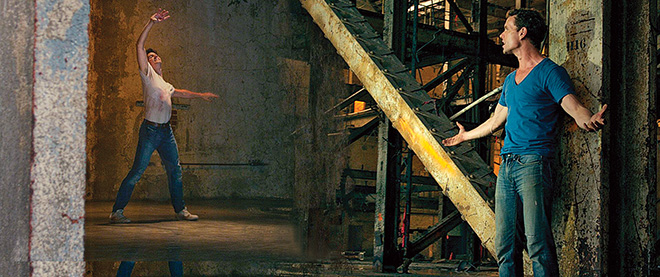Where hockey skills are an asset and tights aren’t required
Emma Teitel on the real dance revolution — in men’s ballet
BravoFACT
Share

You could call it the glass curtain: unlike almost every other industry on the planet, ballet favours women over men. Much of the art’s history is one in which“everything was built for the female,” says Ukrainian ballet dancer and choreographer Ivan Putrov. “The female dancer was the top of the crown.” It’s a man’s world—unless, of course, you’re a man in tights. Every now and then, there was a Nijinsky or a Baryshnikov, but mostly, ballet and its stars were traditionally female.
Now, finally, almost 15 years after the success of Billy Elliot brought ballet into the mainstream and increased male enrolment at ballet schools, the tide has begun to turn. From the lowbrow— the televised dance competition, So You Think You Can Dance—to the high—Putrov’s critically acclaimed all-male ballet, Men in Motion finished its run in London this month—men are no longer shying away from the barre. The School of Alberta Ballet in Calgary, for example, has doubled its enrolment in a boys’ program that launched last year. The class it was to offer in April will likely be moved to September, in part to keep up with growing numbers. Meran Currie-Roberts, the school’s manager of development and communications, says there is “huge demand” for year-round boys programming.
This may have something to do with the way dance is marketed to boys today. The school’s website isn’t subtle about showcasing the similarities between traditionally macho activities and dance. It includes photos of an ice-hockey goalie, a soccer player and a young boy doing the splits in a leotard. Currie-Roberts says the school’s outreach program in rural Alberta always includes jumping demonstrations, “as well as a battle scene from Romeo and Juliet, with prop swords. The boys who have never seen ballet before are just astounded by the athleticism.” The message? Ballet is just as rigorous as any sport, if not more so.
Steven Melendez, a principal dancer with New York Theatre Ballet, would agree. He says he was teased mercilessly as a kid for being a ballet dancer—until the day he caught a baseball in full splits, foot planted safely on base. “Nobody laughed at me after that,” he says. Perhaps it’s the Billy Elliot effect on steroids: ballet isn’t for sissies. In fact, you may be a sissy if you can’t do ballet.
Take Guillaume Côté, a principal dancer with the National Ballet of Canada, who was a hockey goalie while growing up in Lac-à-la-Croix, Que. Côté recently collaborated with Broadway performer Paul Nolan (Jesus Christ Superstar)—who’s now with the Stratford Festival) and was also a hockey kid in Rouleau, Sask.—in a performance of West Side Story’s Something’s Coming, which aired as a short during Cineplex Odeon’s screenings of the Metropolitan Opera this month. Nolan sings, Côté dances. They agree the arts can be sold differently to boys. “One goal in my career is to expose more dance to young men,” Côté says. In a recent project, a short dance piece called Lost in Motion, he wears shorts that wouldn’t be out of place on an Olympian. “I wanted to strip it of the tights and frillies, and just show what it is: awesome and athletic.”
“Everyone thinks of guys in the arts as different,” says Nolan, who was accepted to the prestigious athletics program at Calgary’s Notre Dame High School. “But you can be on a provincial hockey team and you can be on a stage. I think the human mind likes to categorize things and restrict them.” Nolan is aware of the taunting faced by boys in the arts, which is why, he says, he challenges stereotypes in his work. In 2008, he played a gay character in Cabaret. “The obvious thing to do was to make him effeminate,” hew says. “I made him the most dangerous person on the stage.”
Ballet’s new machismo has its drawbacks. Melendez says ever since Baryshnikov “jumped higher than anybody else” and dancing competitions appeared on TV, “there’s almost been an arms race amongst men in ballet over how many times you can jump and how high.” Artistic expression may suffer. “It’s turning into aerobics or gymnastics,” he says, “which makes it more accessible and appealing to a mass audience, but may not be the best thing for ballet.”